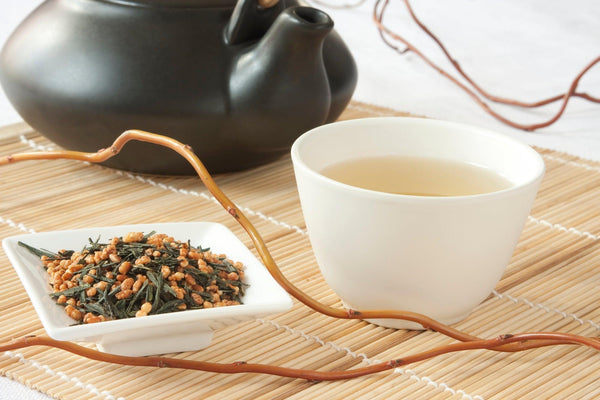
Jump to:
Genmaicha (literally “brown rice tea”) is a popular type of Japanese tea drunk mainly in Japan but is also gaining popularity around the world. It is characterized by its warm, cereal-yellow color and slightly nutty notes. Although considered a green tea, it is actually a blended tea comprised not only of tea but also roasted popped rice, which accounts for it sometimes being labeled “popcorn tea”.
Genmaicha is also called “the people’s tea” and is certainly at the cheaper end of the Japanese tea market. This results from a combination of the fact that it includes rice, which is a cheaper raw material than tea, and commonly “Bancha” tea leaves, the older and least expensive leaves of the tea plant.
Before looking at the health benefits of Genmaicha, as well as the different types of Genmaicha, let’s take a look at how it all started.
Genmaicha – Origins And Dubious Legends
One legend has it that a feudal lord was sitting around drinking tea and his slave, conveniently called “Genmai,” accidentally dropped some rice into his cup. In a fit of rage aimed at the hapless slave, the lord swung his sword and cut off his head. On trying the tea later, however, it was found to be pleasant and so the tea was named “Genmaicha”. No serious tea scholars give this legend any credence, however, and the fact that this story only exists in the English language community is a serious red flag.
A more likely story is that Genmaicha came about in the early 1900s as a result of economic pressures. With the relatively high price of tea, the commoners added rice to their tea to make it go further. They found that adding rice also nullified some of the bitter taste experienced when using the older tougher leaves, and this enabled them to enjoy tea with cheaper ingredients.
How Is It Made?

Despite literally translating as “brown rice tea”, it is not only brown rice kernels that are used. White “mochi” rice may also be used, and the taste of the Genmaicha may differ considerably based on what rice is used.
The rice is soaked, steamed, and dried by blowing hot air underneath it. It is then roasted, and depending on the heat at which it is roasted some of the rice will pop.
It is then added to the tea leaves and stems.
The tea leaves used in regular Genmaicha are the least-expensive, older tea leaves such as Bancha. The earthy notes of the more mature leaves tend to complement the nutty flavors of the rice. As we shall see later, however, there are varieties of genmaicha that use different leaves.
Genmaicha And Caffeine

Depending on your perspective, a drink being low in caffeine can be a good or bad thing, but for the caffeine-sensitive among us looking for a good night’s sleep, the low caffeine content of genmaicha can be considered a welcomed benefit.
Regular Genmaicha uses the older leaves and stems from the later harvests. Caffeine is a defense mechanism produced by the tea plant to make it distasteful to insects. The more mature leaves, which are tougher, are less sought after by the bugs and so don’t need to produce as much caffeine. Adding rice that has no caffeine at all to the mix lowers the average caffeine content even further.
As we shall see when looking at other varieties of Genmaicha, the caffeine content can be either increased or lowered compared to regular Genmaicha, depending on the green tea that the toasted rice is paired with.
Health Benefits

Green tea, in general, is lauded as having a number of health benefits based on its high concentration of antioxidants, in the form of catechins, particularly EGCG, and the amino acid l-theanine. These include weight loss, an immune system boost, skin improvements, and a reduced risk of cancer and strokes. But are there any benefits specific to Genmaicha?
In addition to the normal benefits of green tea, using brown rice in genmaicha may provide other amino acids and phenolic compounds with antioxidant and anti-inflammatory properties that benefit your health, such as gallic acid and egallic acid.
Genmaicha contains GABA (Gamma-Aminobutyric Acid), which is an amino acid that works as an inhibitory neurotransmitter. This helps to reduce certain brain activity, thus promoting relaxation. This, coupled with the low caffeine content, helps to encourage a restful night’s sleep. Genmaicha is also high in minerals, which aids digestion, so similarly to Hojicha, Genmaicha is a perfect after-dinner or late-night tea.
Genmaicha And Fasting
Recently, there has been a lot of attention on the health benefits of intermittent fasting, also known as time-restricted eating, in which the subject deliberately avoids consuming calories for a fixed period of hours or days.
It is perhaps worth noting that traditionally Genmaicha was used by those fasting for religious reasons as the flavor, giving you the experience of eating rice, is said to have a satiating effect without including any calories. Although containing rice, none of the carbohydrates are consumed when drinking it so it is also suitable for those on a keto or low-carb diet.
And even if you are not fasting, drinking Genmaicha may make you feel generally more satiated and work as an effective weight loss tool. Of course, it may all be in the head, but if it works…
Genmaicha vs Hojicha

At this point, let’s look at some of the similarities and differences between Genmaicha and Hojicha.
To start with the ways in which they are alike, both are low in caffeine and are comparatively inexpensive teas. While with Hojicha, the tea is roasted, with Genmaicha it is the rice that is roasted and this gives it the same warm caramel feel as Hojicha, compared to the more grassy, vegetal notes of Sencha. Both are high in minerals and good for digestion.
Despite these similarities, the fact that Hojicha is fully roasted means that it has a more chocolatey feel, compared to the distinctively nutty, slightly sweet, and cereal-like taste of Genmaicha. The addition of rice in Genmaicha also means that it tends to be slightly lower in caffeine than Hojicha.
If you'd like to learn more about other kinds of Japanese green tea and how they compare to genmaicha, be sure to check out this article.
Preparing Genmaicha

Genmaicha is one of the simpler Japanese teas to prepare. Compared to something like Gyokuro, it can withstand hotter water and is less fussy about brewing time.
There is a flash brewing method in which boiling water is added to the pot and it is steeped for just 20 seconds before being served.
An alternative approach is to simply add 5g of Genmaicha to a pot and add around 150 ml of water at a temperature of 80 degrees Celsius and brew it for around one minute.
As the flavors of the toasted rice are fairly robust as well, it retains its flavor even when steeped multiple times. This makes this already inexpensive tea even more economical.
Types Of Genmaicha
The different types of Genmaicha differ in terms of what kind of leaves are used in addition to the toasted rice. The Genmaicha we have been discussing so far, which uses the older Bancha leaves, would be classed as regular Genmaicha.
Some other varieties include the following:
Hojicha Genmaicha

This combines Hojicha, which is a green tea that has been roasted to a reddish-brown color, with the toasted rice. As Hojicha is already low in caffeine, adding the rice makes Hoji Genmaicha very low in caffeine. For this reason, Japanese people are very happy serving it to children.
Sencha Genmaicha

Unlike bancha commonly used in Genmaicha, Sencha uses the first or second flushes of the harvest and the leaves are younger and sweeter. Sencha Genmaicha combines these leaves with toasted rice. This makes it somewhat more expensive and higher in caffeine than regular Genmaicha. Fans of the sweeter notes of Sencha may enjoy this blend, although some Genmaicha purists claim these clash a little with the flavors of the toasted rice.
Gyokuro Genmaicha

Genmaicha combines toasted rice with Gyokuro. Gyokuro uses only the top three leaves of the tea plant and is shaded for a full three weeks before harvesting. Accordingly, this will be much sweeter, much more expensive, and much higher in caffeine than regular Genmaicha.
Matcha Genmaicha

Matcha is a type of green tea in which the younger tea leaves are ground into a fine powder. In the case of Matcha-Iri Genmaicha, this powder is added to the leaves and toasted rice to make a powerful green tea infusion. This tends to be much higher in caffeine than regular Genmaicha. While worth trying if you are a fan of Matcha, many tea drinkers familiar with regular Genmaicha find that the strong flavor of the Matcha overwhelms the cereal notes of the toasted rice.
Where To Buy Genmaicha
Although most commonly drunk in loose-leaf form, Genmaicha is also available in tea bags, powdered form, and in sweets and confectionery. You will be able to find it quite easily in supermarkets and tea stores, as well as online stores. If you want to buy authentic Genmaicha straight from Japan, be sure to check out our selection at Japanese Taste.
Genmaicha – The People’s Tea
Genmaicha is the most popular blended tea in Japan. Whereas it likely started as an economic measure to make the tea go further by adding rice, it has become an established firm favorite among the Japanese tea-drinking community.
Being low in caffeine and including minerals that help with digestion, it is a great tea to enjoy after your evening meal.
Its overall low price, added to the fact that the same leaves can be steeped multiple times, mean that genmaicha is a way to drink Japanese tea that is great for your general health without blowing the household food budget.
Have you tried genmaicha yet? If so, let us know in the comments how you like it compared to other types of Japanese tea.



0 comments